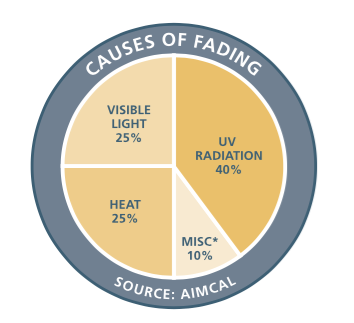
Sunlight Fading Hardwood Floors
We all know that direct sunlight causes fading of hardwood floors; it can be a problem for any homeowner. If your flooring was finished with a traditional polyurethane or oil-based varnish, not only will your wood fade overtime, it will also take on a yellow hue. Sunlight Fading Hardwood Floors
Most of us have moved a rug or a piece of furniture and noticed the covered part of the floor is either lighter or darker than the surrounding wood.
Why Wood Floors Darken or Fade when exposed to Sunlight? Sunlight and Fading Hardwood Floors
The longer the wood has been covered up, the more noticeable the difference in colour will be. Why does this happen? Can anything be done to prevent it? Sunlight and Fading Hardwood Floors

Fading, bleaching and darkening in hardwood floors due to sunlight exposure is a complex subject. Ultimately, color deterioration in hardwood floors is the result of overexposure to three elements: ultra violet (UV) light, visible light and the infrared (IR) light which creates solar heat.
How fast a timber reacts to UV light depends on the species of wood.
Tropical, exotic woods used in flooring, like Brazilian Cherry or Tigerwood, will react to UV rays exposure quite fast and will turn a much darker shade. DA domestic species of wood, on the other hand, such as Red or White Oak, Hickory or Maple will bleach overtime and become lighter, but at a much slower rate.

Furthermore, it is not only the wood itself that is subject to discoloration; the type of finish on the wood flooring will also play a substantial role on how the wood will react to sunshine.
Infrared light, combined with UV light and visible light, reacts with the finish and slowly turns the finish darker or gives it a yellow tint. That’s why over a long period of time certain types of hardwood floors with oil based polyurethane finish turn that yellow or more so orangey color that people no longer want.
What Can Be Done to Stop Sunlight from Damaging your Hardwood Floors?
Unfortunately, sunlight exposure will result in fading of hardwood floors overtime. There is not much that can be done to completely prevent this. The issue of fading and color change from exposure to direct sunlight does not have a single solution that would fix this problem. There are however, steps that can be taken, to substantially minimize the fading process, if implemented together. It will not completely stop the fading and discoloration, but it will slow the process down. Sunlight Fading Hardwood Floors
Move Rugs and Furniture Within the Rroom
From time to time, rearrange your furniture and floor coverings to allow sunlight to hit the previously covered areas of your floors. This will equalize the UV and IR light exposure and even out the fading process so a consistent color will be achieved within the entire room.
Consider Window Coverings that will Reduce the Sunlight Entering the Room
It makes sense that if you can keep sunlight off your floor it won’t fade as much. Drapes, curtains, shutters or blinds are some of the best defenses against fading hardwood floors. If you keep them closed on the side of your house when the sun is hitting the windows it will drastically cut down on any UV and infrared light reaching the floor.
If you have mini blinds or other types of horizontal louvers and you don’t want to shut them completely, position the slats so that they angle upwards allowing the sunlight to be directed towards the walls and ceiling instead of towards the floor.
You may also consider installing a UV protective film on the glass of your windows.
You may also want to look into motorized shades that can be set to use the timer or other Smart Home Solutions like Google Home or Alexa, that will operate the window shades throughout the day as needed.
Finishes with UV Inhibitors Sunlight Fading Hardwood Floors
Hardwood floor finishes are continually being improved, and component being developed to improve the degree in which the wood is protected from UV damage and the fading and discoloration. Regrettably, there is no finish available at this time that would completely protect the flooring from harmful UV rays.
There are finishes though that will slow the fading process down. The best finishes to slow down fading at the moment are high-end water-based systems. This is one of the reasons why we have been using Bona products for the last 25 years... because they help reduce amber discoloration and fading, and at the same time are highly durable.
Bona products are known to be a environmentally sensitive and their waterborne finishes will not change the colour to yellow overtime.
Low-E Glass Windows
Another, highly recommended change that can be done when time comes for renovations, is the installation of a quality Low-E (low-emissivity) glass windows. These windows have special coatings that do a great job limiting the amount of UV and IR light that passes through the panes. There are a few different types of low-e glass windows and you need to talk to a glass professional to see which ones are suited to your home. Here is more on this from a window company.
What can be done if your flooring is already faded and discolored from exposure to Sunlight.
Regrettably, the only solution to remedy the problem of faded or discolored hardwood flooring is to sand and refinish the wood and apply a high quality water based varnish to protect the wood for the future.
It is important to understand that in some instances, especially when it comes to exotic species some boards that became darker overtime may not be reverted back to the original colour and may still read darker after refinishing.
Return to Home Page


















New! Comments
Have your say about what you just read! Leave me a comment in the box below.